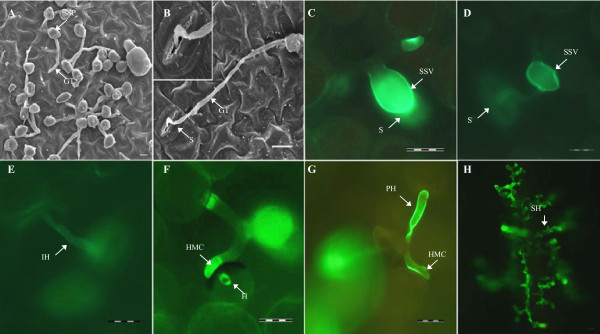Figure 2.
Infection features of P. striiformis f. sp. tritici ( Pst ) on broad bean. (A) Germinated Pst urediniospores (SP) producing germ tubes (GT) growing in random directions at 6 hpi. (B) Germ tube (GT) that has successfully located and entered a stomate (S) at 12 hpi. (C) A normal oval substomatal vesicle (SSV) formed within the substomatal chamber and adjacent to the stomate (S) at 24 hpi. (D) An irregularly shaped SSV formed far from the stomate (S) at 24 hpi. (E) Some infection units did not contain a SSV structure and directly produced infection hyphae (IH) at 24 hpi. (F) A Pst haustorium (H) within a mesophyll cell after penetration by a haustorial mother cell (HMC) at 24 hpi. (G, H) Broad bean and wheat inoculated with Pst , respectively, at 168 hpi. Only one or two primary hyphae (PH) were produced and the vast majority of the Pst infection hyphae were blocked at HMC formation in broad bean leaves compared with extensive colonization and formation of secondary hyphae (SH) in wheat leaves. Leaves were examined under a scanning electron microscope (A, B) and under an epifluorescence microscope after staining with Calcofluor (C–E), or with WGA-alexa staining (F–H). Bar = 20 μm.

